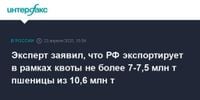In April 2025, Russia's wheat exports have taken a significant downturn, with only 1.3 million tons shipped in the first 20 days of the month. This figure represents a staggering 2.8 times drop compared to the same period last year, highlighting a troubling trend for the country's agricultural sector. It is projected that the total wheat exports for April will only reach 2 million tons, markedly below the average five-year level of 3.5 million tons. This marks the fourth consecutive month that export volumes have failed to meet expectations.
The decline in exports can be attributed to several factors, including low profit margins, a loss of competitiveness in the global market, and waning enthusiasm from key buyers. The number of countries importing Russian wheat has plummeted from 35 to just 15. Among these, Iran, Turkey, and Libya have emerged as the largest buyers, but even these markets have shown a decrease in volume. For instance, Egypt has cut its purchases by an alarming 8.2 times, while Israel, Saudi Arabia, and Yemen have also significantly reduced their imports.
Interestingly, some countries like Lebanon, Tanzania, and Oman have recorded slight increases in imports, although overall volumes remain low. In a recent development, Algeria's OAIC agency purchased 570-600 thousand tons of wheat from unspecified origins at a price of $267.5 per ton C&F. Analysts suggest that Russian wheat was priced $2-3 higher, which could have influenced Algeria's decision to look elsewhere for suppliers.
The pricing landscape is further complicating matters for Russian exporters. Currently, the price of Russian wheat (FOB Novorossiysk) ranges between $250-254 per ton, which is higher than its French counterpart at $244 and American wheat at $231. This pricing disparity makes it challenging for Russia to maintain its export potential at levels seen in previous years, especially amid increasing competition.
In addition to pricing issues, the number of market participants has dwindled from 67 companies to just 21, while the number of operational ports has decreased from 24 to 11. The Black Sea region has seen the most significant losses in port activity, with the only exception being the Baltic port in Vysotsk, which has managed to increase its transshipment volumes.
According to the analytical center SovEcon, Russia's total wheat exports for the 2024-2025 season are expected to reach 40.7 million tons. In contrast, the U.S. Department of Agriculture forecasts slightly higher exports at 44 million tons. Given the high prices and limited supply in the domestic market, restoring competitiveness will be a formidable challenge.
Further discussions on the future of the grain and oilseed market in Ukraine and the Black Sea region are set to take place at the 23rd International Conference BLACK SEA GRAIN.KYIV, scheduled for April 24, 2025, in Kyiv. This conference aims to facilitate strategic discussions and networking among industry leaders.
In a related context, an expert has recently commented on Russia's wheat export quota, which stands at 10.6 million tons for the period from February 15 to June 30, 2025. The General Director of ProZerno, Vladimir Petrichenko, predicts that Russia will export no more than 7-7.5 million tons under this quota. As of now, 83% of the quota has been allocated, but the current slow pace of exports suggests that even these figures may not be fully realized.
Petrichenko expressed concerns during the XIX International Conference "Kombikorma - 2025" held in Moscow, stating, "The fulfillment will be at the level of 7-7.5 million tons." He noted that exports of barley and corn are currently stalled, further complicating the situation for grain producers.
The expert forecasts that by the end of the current agricultural season, total wheat exports could reach 40 million tons, a significant decline from 54.1 million tons in the previous year. The overall export potential for all grains this season is estimated at 48-49 million tons, down from 72.2 million tons.
This sharp drop in exports signals a worrying trend for the Russian grain market, which has ceased to function as a locomotive driving demand and prices. Petrichenko noted that domestic demand is not supportive of grain producers either, with a projected decrease in grain consumption by 1 million tons, bringing it down to 84 million tons.
The market situation appears paradoxical, characterized by low grain reserves coupled with low consumption levels. Petrichenko pointed out that this situation is abnormal, attributing it to strong exports during the first half of the previous season (July-December 2024). The result has been low transitional stocks in agricultural organizations in the South and Chernozem region, while conditions are somewhat better in the Volga region and beyond the Urals.
On the global stage, Petrichenko remarked on the intense competitive environment, stating, "We have been competing at similar price levels since November, creating a dense market landscape." He emphasized that there are no promising prospects for price increases in the export sector, while the potential for price reductions exists. However, to lower prices, there must be an available supply of grain, which is currently lacking due to low reserves.
Looking ahead, the price for the new wheat crop is anticipated to fall within the range of $220-240 per ton, compared to the current $250 per ton (FOB). Petrichenko cautioned that a strengthening ruble could further complicate Russia's export endeavors, indicating a challenging road ahead for the country's wheat market.

